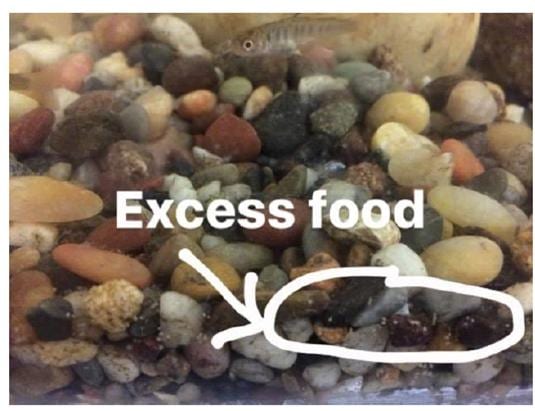Other teachers have complained that the salmon tank smells bad. Is there anything I can do, besides regular water changes?
There are only a couple times you should expect “fishy” smells with SITC: during a dissection activity, or when you open your ziplock baggie of salmon chow. The salmon tank itself really shouldn’t smell bad. Excess waste in your tank can cause bad smells and poor water quality. (And by waste I mean excess food or fish poop.) Resolving this issue will not only increase your popularity among your fellow teachers, it’s necessary for keeping your fish healthy.
To solve the Bad Smell Mystery, start by answering the questions below. This may help you identify the source and location of the excess waste, and what to do about it.
1. Are you overfeeding your fish?

-
Unlike trout, salmon will not eat food pellets once it’s on the gravel. That means if you see any excess food on the gravel, it will begin to decompose and add toxic ammonia to your tank. If left to rot on the gravel, excess food can quickly become colonized by bacteria or fungus, and will start to look like alien slime.
-
Let your feeders know that fish are cold-blooded and don’t have to maintain their body temperature with their metabolism, like us… meaning, they don’t need to eat that much! Only 2% of their body weight per day. You can get students to weigh samples of your fish and calculate how much food they need using the formulas in The Need For Feed activity (Kids + Net + Baby Salmon + Formulas = SO FUN).
2. Is waste accumulating in your gravel?
Each school has to figure out the cleaning schedule that works for them. There are a lot of factors that go into this (i.e. amount of food entering the tank, water hardness, population size, etc). Some tanks do well with one water change per month, others really need once per week. Some excess waste will hide from view in the gravel, and is visible as a debris cloud in the gravel vacuum only once you begin cleaning the tank. If you’re seeing a lot of debris getting sucked up in the gravel vacuum at each cleaning, consider adjusting your feeding and cleaning schedule.
3. Is waste accumulating in your filter?
It’s easy to overlook the filter during tank cleanings, but it can be a “sink” for excess waste. If your filter is doing a good job trapping excess waste and debris, the inserts will become saturated with gunk (see photo below!). Check the filter inserts for debris when doing your water changes. These should be rinsed in dechlorinated water at least once per month. Resist the urge to replace all the filter inserts at the same time, because your beneficial bacteria friends live there. Also check for debris trapped in your filter intake tube, and clean that if needed.

4. Is your tank over-crowded?
Your tank can easily support 250 eggs and 250 alevin. Once your fish are buttoned up and eating fish food, the nitrogen load in the tank increases (more waste decomposing!). As your fish get bigger and bigger, your tank will reach its carrying capacity. SITC prefers that you keep at least some fish in your tank through May, so students have more time to interact with the tank. However, you’ll want to release a portion of your fish by Spring Break time. You may need to do a few releases in the spring. Keep track of the release dates and number of fish released each time, and report all your info once all your fish are gone. If you need volunteers to help with this, contact the SITC Coordinator.
If your tank smells, regular water changes should help a lot. Start there, and contact the SITC Coordinator if the smell continues. We can also test the nitrate levels in the water to make sure they’re safe for your salmon.

